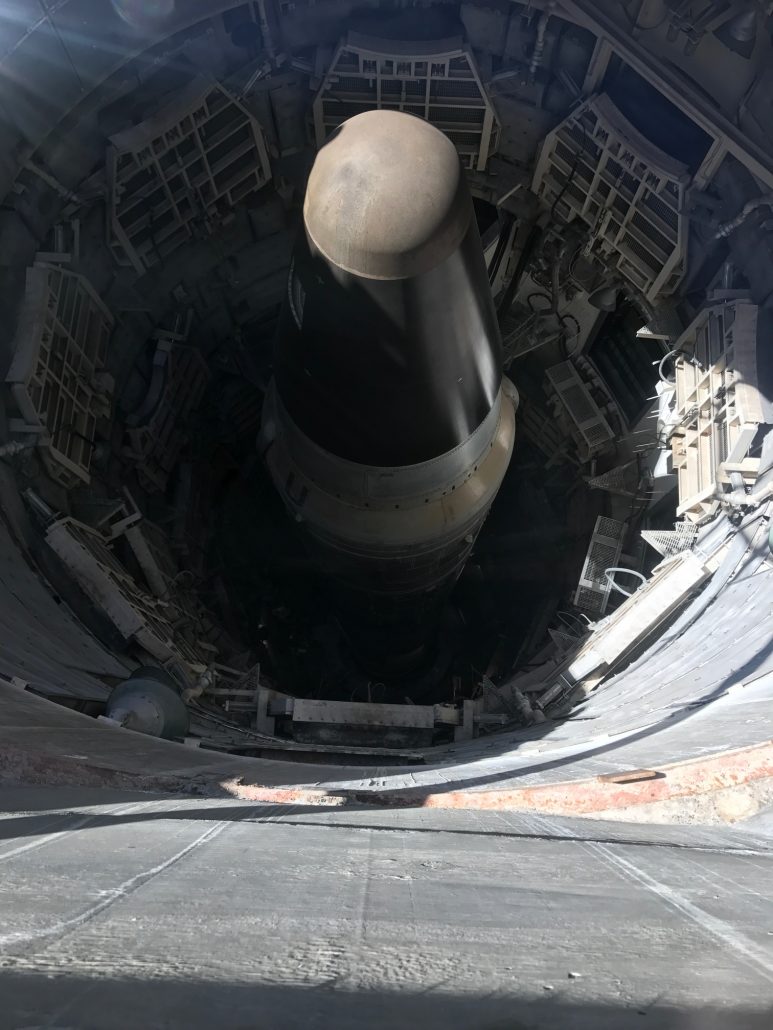As it is July 16th, the anniversary of the dawn of the Atomic Age, I suppose it’s time to get to the third and final part of the Atomic Holiday.
The whole genesis of this trip was the fact that we could go visit the Trinity Test Site on April Fools Day, along with all the other doofuses like us that thought going to walk around at ground zero was a pretty neat idea. To do that means you to actually have to get there first. As the open house website says, the Stallion Gate checkpoint to White Sands Missile Range (WSMR) opens at 8am and there will be people lined up waiting for that. If, like us, you began your journey in Albuquerque, that means you have a roughly two hour drive ahead of you before you even hit the Stallion Gate Rd. turn off from US380. Depending on when you’re get there, it may be another two hours before you make it from the turn off to the checkpoint. I recommend stopping in San Antonio to use the bathroom and stock up on water & snacks, which I DOUBLE RECOMMEND not consuming until you get to the Trinity Site parking lot. Don’t have more regrets than necessary in that long traffic line.

FAIR WARNING: the turn on to Stallion Gate Road from US380 isn’t well marked, but the steady parade of cars and the protesters should give you a good hint that you’re in the right place. Also, pretty much the moment we hit the turn off, our cell signal dropped to zero for our entire time on WSMR. If you’re trying to rendezvous with folks, you better set up your meeting place & time in advance because you may not be able to get in touch with each other once you get there. May I recommend the Jumbo vessel as an excellent landmark for this.
Ah, yes, the protesters. A life spent growing up around Santa Cruz and the SF Bay Area, and then working at LLNL & UC Berkeley, has left me with a jaundiced outlook toward protesters, mainly because they usually lose their message to useless incoherence the more of them that are there. One of the games I like to play when approaching a protest is to look for a lonely “FREE LEONARD” sign in the crowd; that’s my signal that a protest has gotten sufficiently large that it collectively doesn’t know why it’s here anymore. I try to count the number of people present and guess what the magic number was when sign appeared. I refer to this number as the Peltier Limit. (Exception: a FREE LEONARD sign is always relevant at Native American rights protest)
This was not one of those protests. Their complaint was crystal clear and unified in a way I’ve rarely encountered.
Rather than go in to detail about the grievances of the denizens of Tularosa, I’ll sum it up with this: it is rude to set off an atomic weapon in the vicinity of people and then not do follow up. “We’d never done this before and didn’t know what would happen” isn’t a great excuse for not doing much of anything for the next 70 years. If you’d like more thorough reporting on the topic, Kelsey Atherton did a damn fine write up on it. I have gone through the Tularosa Basin Downwinders’ and the CDC study proposal’s papers and I come down strongly on the side of “Do what science you can this far after the fact.” From a health physicist point of view, this population constitutes a study cohort…if you take the time to actually study them. Considering we’ve already nuked them once without really asking, it would be considerate to at least involve them in the study at this stage, if only for very self-interested reason that it is much easier to study a cooperative population.
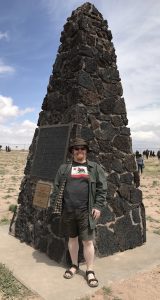
Once you get through Stallion Gate, you have a helpful marked route out to the parking lot outside the fenced of Trinity Test Site itself. If you really, really need to pee after that long wait in traffic, there is a bathroom halfway along the WSMR drive to ground zero (the walk from wherever you get to park in the Trinity parking to the outhouses may be more than you can take, depending on desperation level). President Eisenhower opened up the site in 1953 (after the Atomic Energy Commission decon’d it) with the surface level noble principle that the American people spent two billion 1940s yanquibuxx and should be able to see what they got for it. The deeper, less noble principle was a demonstration that you could set off an atomic weapon and, soon enough, it was safe to visit ground zero. That we had this shit under control. While the original open houses through the 1970s happened in July for the test anniversary, they moved to April & October later on because July is a fucking miserable time to be out there. There’s a reason the non-gypsum dune part of that area is also known as Jornada del Muerto (rough translation from my terrible high school Spanish, “Trail of Death”). It was designated a National Historic Landmark in 1975 and incorporated into the White Sands National Monument.
The open house was a surprisingly well attended even with the level of security, and even shuttles, which I assume the Army isn’t entirely thrilled about having to provide. While the White Sands National Monument (WSNM) has a nice continuous chunk of land south of the missile range, the Trinity Test Site is smack in the middle of the northwestern chunk of Army territory. Because it is designated as public land, the general public must be granted access to it at least one day a year. This means you can’t shoot missiles at this general area during the open house, which I assume is a real bummer in the WSMR planning office. It is, however, an absolutely gold star event for the WSMR PR folks to put a good face on “we blow the shit out of some of the most beautiful parts of New Mexico including, once upon a time, with Gadget”.
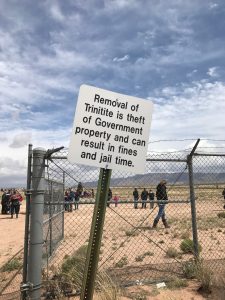
This sign greets you before you walk into the fenced off ground zero area. As I said before, the AEC cleaned up most all of the radioactive fused glass from the atomic test, AKA trinitite, before letting the public in but they didn’t get it all. In fact, they missed some fairly large chunks. There’s some unfissioned leftover plutonium in the trinitite and technically speaking all plutonium in the United States belongs to the federal government. If you have some plutonium in your laboratory, you have it on loan from the feds who may take it back anytime they feel like and you are required to inventory & submit reports on it. This is why you aren’t allowed to stuff your pockets full of trinitite, not that there is all that much of it left at the test site.
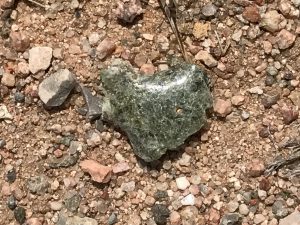
“But Phil,” I hear you ask “What about all the trinitite that got used in paperweights, jewelry, and novelty pens or just straight up chunks that I can buy on the Internets?” For that stuff, the cat is out of the bag and it can be freely traded. As Martin, who guest starred in part one of this adventure, said in the Atlas Obscura article about trinitite “It is the traditional gift of nukewonks.” While wandering around east of the obelisk, My Lovely Assistant found a beautiful half-dollar sized piece which we took a picture of and then put right back down on the ground. Playing happy camper, taking only pictures and leaving only footprints, we made sure that this was there for someone else to discover again in the future. Hopefully, they’ll leave it there too because that was some damn pretty slightly radioactive jade.
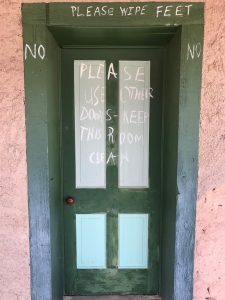
Trinity ground zero isn’t the only place you can visit out there. When the historical monument designation was given, they also included one of the instrumentation bunkers and the McDonald ranch house. From the parking lot you can jump one of the Army buses that will take you on the bumpy ride out to the location where the final assembly on Gadget was done. Other than the historical curiosity of what happened here, the ranch house and out buildings are somewhat unremarkable until you stop and consider “They turned a rancher’s living room into a weapons assembly clean room.” Well, a less dirty room perhaps, you take what you can get out here. The chalk marks on the posts and lintel for this door are recreations from the restoration work to stabilize the decaying building, with exquisite care done to recreate what the exterior looked like in the days before July 16, 1945.
Looking out across the desert to the south from the ranch house, there is a low fence and gate. I’m not sure exactly what they were hoping to keep out, but it sure wasn’t the Army. The McDonalds hadn’t wanted to give up their ranch in the first place and the decidedly did not get it back after the war, as they’d been hoping for. Eminent Domain is a bit of a bastard that way.
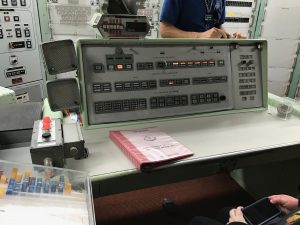
After Trinity was the long drive Tuscon, with a VERY EDUCATIONAL REST STOP on the way, and the following day the Titan Missile Museum in Sahaurita, AZ. If you played Fallout New Vegas’s Lonesome Road expansion, you are very familiar with what the nose cone of a Titan II looks like and have detonated many if you were trying for that achievement. Alternatively, if you watched Star Trek First Contact, you’ve seen this specific silo and missile as it was filmed here. As a recommendation, if you are going for a special occasion, saaaaay someone’s birthday, let your guide at the Titan Missile Museum know and you might get to turn the keys on a simulated launch alert. As my Lovely Assistant would prefer I not put her picture up, let me show the console after she turned the launch key, successfully executing her duties as an acting missileer major.
The normal tour here lasts about an hour, though you’re welcome to fart around for as long as you like topside. For those with more time to spend in Tuscon, the Titan Missile Museum is affiliated with the Pima Air & Space Museum with their amazing boneyard of parked/derelict planes. You could do both in the same day, but I’d really recommend giving a full day to the boneyard tour. And, as someone who works with derelict, decades old and hard to repair equipment all the time, I would like to reiterate the Titan Missile Museum’s admonition against touching things or even leaning against walls. This place, and most of the equipment in it, is now unique; if you break something, it’s gone forever. The rest of the Titan II sites were destroyed as part of an arms reduction treaty, with this one kept as a museum. A hole was cut in the skin of the missile to make sure it would never fly again and the silo doors have been permanently locked open with bollards put in place to keep them that way…and thus easily verifiable from orbit.
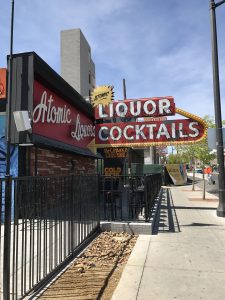
The end of the line for this road trip was Las Vegas and bachelor party I needed to attend. And, as always, if I’m going to Las Vegas, I’m going to take a trip to the National Atomic Testing Museum. And, as per usual, every time I go to the NATM I come away with something new I want to go track down. We decided to end of our atomic history roadtrip by visiting the physical site of some the vestigial Atomiciana of Rat Pack Vegas era in a picture we saw at the museum. Atomic Liquors did not disappoint with their decent booze selection and I strongly recommend reading their history page on the website. When you hold Las Vegas Liquor License #00001, you’ve got some stories to share. Their attached restaurant, The Kitchen at Atomic, was closed when we went there so I can’t tell you how the food was. It’s design, however, reminded me of some of the research reactor buildings I’ve visited over the years. If they haven’t tried to approximate Cherenkov blue in a cocktail, and stuck that in the name, they’re missing out on a nuke nerd branding opportunity.
In conclusion, let’s try not to add any brand new sites to my southwest atomic history road trip, okay?
